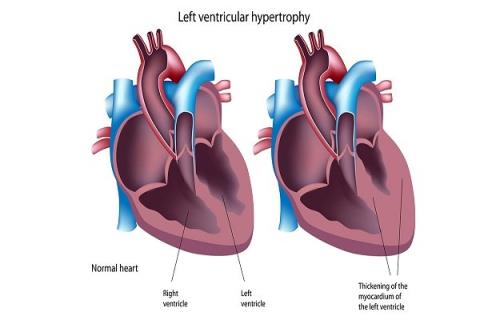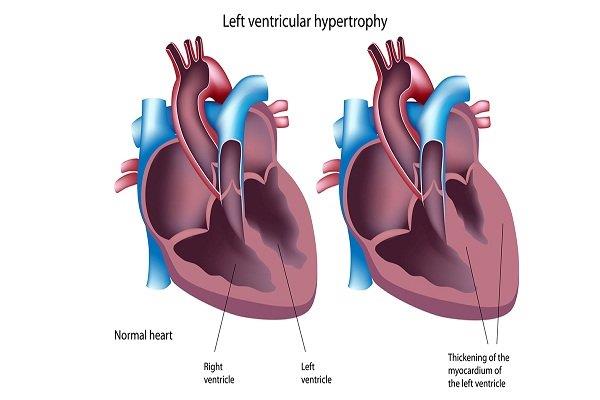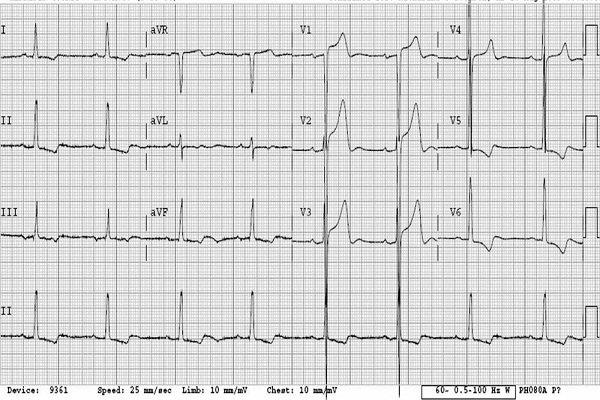Left ventricular hypertrophy: Causes, symptoms, diagnosis and treatment

Left ventricular hypertrophy is one of the most common cardiovascular diseases. This is often a complication of certain diseases of the cardiovascular system. Sometimes hypertrophy is due to congenital causes. So what is the cause of this disease? What are the symptoms? How is the treatment? All will be answered through the following article.
content
- 1. Concept of left ventricular hypertrophy disease
- 2. Status of LVH
- 3. Causes of LVH
- 4. Risk factors for LVH
- 5. Symptoms of LVH
- 6. What are the complications of left ventricular hypertrophy?
- 7. When to see a doctor?
- 8. How is left ventricular hypertrophy diagnosed?
- 9. Treatment of left ventricular hypertrophy
- 10. Lifestyle change problem
1. Concept of left ventricular hypertrophy disease
Left ventricular hypertrophy is also known in English as Left ventricular hypertrophy , abbreviated as LVH . This is the enlargement and thickening (hypertrophy) of the walls of one of the heart's two main pumping chambers - the left ventricle. This is one of the four main chambers of the heart that perform the pumping action.

Left ventricular hypertrophy
Left ventricular hypertrophy can develop in response to a number of factors. Such as high blood pressure or an overworked heart condition. It causes the left ventricle to work harder. As the workload increases, the muscle tissue in the wall of the left ventricle thickens. And sometimes the size of this heart chamber itself also increases.
See more: How dangerous is an enlarged heart?
The enlarged heart muscle loses elasticity and may eventually fail to pump as forcefully as it should. Left ventricular hypertrophy is more common in people with uncontrolled high blood pressure. But regardless of your blood pressure, developing left ventricular hypertrophy puts you at increased risk for heart failure and stroke. Treating high blood pressure can help ease your symptoms. It is also possible to reverse this hypertrophy.
2. Status of LVH
Left ventricular hypertrophy is present in 15% to 20% of the general population. It is more common in black people, the elderly, the obese, and patients with high blood pressure. A review of echocardiographic data of 37,700 people found the prevalence of LVH to be 19% to 48% in untreated hypertensive subjects. And 58%-77% in high-risk hypertensive patients.
See more: Heart valve disease: Early recognition for effective treatment
The presence of obesity also doubled the risk of developing LVH. The prevalence of LVH ranges from 36% to 41% in the population, depending on the criteria used to define it. The prevalence of LVH was not reported to differ between men and women (approximately 36.0% versus 37.9%.) The prevalence of eccentric left ventricular hypertrophy was relatively higher than that of concentric hypertrophy.
3. Causes of LVH
Left ventricular hypertrophy can occur when certain factors make your heart work harder than usual to pump blood to your body. Factors that can make your heart work harder include:
- High blood pressure (hypertension). This is the most common cause of LVH. More than 30% of people showed evidence of left ventricular hypertrophy at the time they were diagnosed with hypertension.
- Aortic valve stenosis. This disease is a narrowing of the aortic valve that separates the left ventricle from the aorta. Aortic stenosis requires the left ventricle to work harder to pump blood into the aorta.

Aortic valve stenosis
- Hypertrophic cardiomyopathy. This genetic disease occurs when the heart muscle becomes abnormally thick. Even with perfectly normal blood pressure, it makes it harder for the heart to pump blood.
- Physical training. High-intensity, prolonged endurance and strength training can adapt the heart. The purpose is to handle the increased workload. It is unclear whether this type of athletic left ventricular hypertrophy can lead to myocardial sclerosis and disease.
4. Risk factors for LVH
In addition to hypertension and aortic stenosis, factors that increase the risk of LVH include:
- Age. Left ventricular hypertrophy is common in the elderly.
- Weight. Being overweight increases the risk of high blood pressure and left ventricular hypertrophy.
- Family history. Several genetic conditions are associated with developing left ventricular hypertrophy.
- Diabetes mellitus (diabetes). Left ventricular hypertrophy was found to be associated with a higher risk of diabetes.
- Race. African-Americans have a higher risk of left ventricular hypertrophy than whites with similar blood pressure measurements.
- Sex. Women with hypertension have a higher risk of left ventricular hypertrophy than men with similar blood pressure measurements.

African American
5. Symptoms of LVH
Left ventricular hypertrophy usually develops gradually. You may experience no signs or symptoms, especially in the early stages of the condition. As left ventricular hypertrophy progresses, you may experience:
- Shortness of breath, difficulty breathing. Shortness of breath sometimes with sitting or paroxysmal nocturnal dyspnea.
- Fatigue often.
- Chest pain, often after exercising or being active.
- Feeling of a fast or pounding heartbeat (palpitations, palpitations)
- Dizziness or fainting.
- Recurrent lung disease, such as pneumonia, bronchitis.

Shortness of breath is a common symptom
6. What are the complications of left ventricular hypertrophy?
Left ventricular hypertrophy alters the structure and functioning of the heart. An enlarged left ventricle can cause:
- Weakens the body.
- The heart muscle stiffens and loses elasticity, preventing the chambers of the heart from filling up with blood.
- Increased pressure in the heart leads to an increased risk of dilatation of the whole heart.
- Compress the blood vessels of the chambers (coronary arteries) and restrict the blood supply to the coronary arteries.
- The results of these changes can lead to the following complications:
- Reduced blood supply to the heart.
- The heart is not able to pump enough blood to the body (heart failure).
- Abnormal heart rhythm (arrhythmia)
- A fast, irregular heartbeat (atrial fibrillation) reduces blood flow to the body.
- Insufficient oxygen supply to the heart (ischemic heart disease)
- Stroke.
- Loss of heart function, apnea, and sudden, unexpected loss of consciousness (sudden cardiac arrest).
7. When to see a doctor?
You need to seek emergency medical attention if:
- Feeling chest pain that persists for several minutes
- Having difficulty breathing from severe to severe
- You are severely shocked or lose consciousness
If you experience mild shortness of breath or other symptoms, such as palpitations, see your doctor. People with high blood pressure or another condition that increase the risk of left ventricular hypertrophy. Doctors may then recommend regular appointments to monitor your heart.
See also: Malignant hypertension: Symptoms and treatment methods
Even if you feel well, you need to have your blood pressure checked every year or more often if you:
- Smoke
- Overweight, obese
- There are other conditions that increase your risk of high blood pressure. For example, salty eating habits, autonomic disorders, hyperthyroidism, etc.
8. How is left ventricular hypertrophy diagnosed?
Your doctor will start with your medical history, family history, and a thorough physical exam, including checking your blood pressure and heart function. Your doctor may then recommend screening tests:
- Electrocardiogram (ECG). Electrical signals are recorded as they pass through your heart. The doctor can detect abnormal heart function and left ventricular dilatation on the electrocardiogram.
- Echocardiography. Sound waves create a live picture of the heart's workings. Echocardiography can reveal thickened muscle tissue in the left ventricle. It also shows the blood flow through the heart with each beat. Same heart abnormalities associated with left ventricular hypertrophy, such as aortic stenosis.
- Magnetic resonance imaging. Imaging of the heart can be used to diagnose left ventricular hypertrophy.

Electrocardiogram of left ventricular hypertrophy
9. Treatment of left ventricular hypertrophy
Treatment of LVH depends on the underlying cause and may involve medication or surgery.
9.1. Treatment of aortic valve stenosis
Left ventricular hypertrophy due to aortic stenosis may require surgery to correct the stenosis. Or, the narrowed aortic valve can be replaced with an artificial valve or a biological valve.
9.2. Treatment of hypertrophic cardiomyopathy
LVH caused by hypertrophic cardiomyopathy can be treated with medication. It can also be treated with non-surgical procedures, surgery, implantable devices, and lifestyle changes. Your doctor will likely recommend heart-healthy lifestyle changes, including:
- Exercise regularly.
- Eat a diet rich in fruits, vegetables, whole grains, and good fats. Also reduce your intake of refined carbohydrates, salt, and saturated fat.
- Give up smoking.
9.3. Treatment of high blood pressure
Hypertension is one of the common causes of LVH. Therefore, to stabilize blood pressure in people with hypertension, we should take antihypertensive drugs regularly every day. Be sure to take the correct dose and time as directed by your doctor. Some common classes of drugs that help lower blood pressure include:
- Group of beta-blockers.
- Alpha blockers or both alpha and beta sympathomimetic blockers.
- Calcium channel inhibition.
- Vasodilators: Dilate arteries, veins, or both.
- Group of diuretics.
- ACE inhibitors or Angiotensin II receptor blockers.
- Centrally derived sympathomimetic...
9.4. Treatment of sleep apnea
If you've been diagnosed with sleep apnea, treating this sleep disorder can lower your blood pressure. It also helps reverse left ventricular hypertrophy if the cause is high blood pressure.
You have not been diagnosed with sleep apnea, but someone in your family has told you that you snore or that you stop breathing for a moment while you sleep. Then, talk to your doctor about getting tested for sleep apnea.
Read more: Infective endocarditis: risk of acquisition and prevention
Treatment for sleep apnea involves using a machine that provides continuous positive airway pressure (CPAP) while you sleep. CPAP keeps your airways open. It allows you to get the oxygen you need to keep your blood pressure in the normal range.
10. Lifestyle change problem
Lifestyle changes can help lower blood pressure, improve heart health, and improve signs of left ventricular hypertrophy if LVH is caused by high blood pressure. Some recommended measures include:
- Weight loss.
- Increase fiber, vegetables and fruits in the daily diet.
- Limit salt, starch, and saturated fat.
- Regular physical activity.
- Limit stress.

Increase fiber in the diet
In summary, left ventricular hypertrophy can be a primary pathology. It can also be secondary to a cardiovascular disease. Therefore, we should manage cardiovascular diseases well. At the same time, have a scientific lifestyle as recommended by experts. The goal is to promote health and limit the risk of heart diseases.
See also: Can the right ventricle with two outflow tracts be treated?
Dr. Nguyen Lam Giang